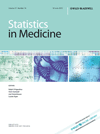
STATISTICS IN MEDICINE
Scope & Guideline
Elevating biomedical research through rigorous statistical dialogue.
Introduction
Aims and Scopes
- Statistical Methodologies in Clinical Trials:
The journal emphasizes innovative statistical approaches for the design and analysis of clinical trials, including adaptive designs, Bayesian methods, and hybrid designs that integrate real-world data. - Epidemiological Studies and Health Outcomes Research:
It covers statistical methods for observational studies, including causal inference techniques, survival analysis, and modeling of time-to-event data to assess health outcomes. - Biostatistics and Machine Learning Integration:
The integration of machine learning techniques with traditional statistical methods is a key focus, exploring how these approaches can enhance predictive modeling and treatment effect estimation. - Longitudinal and Multivariate Data Analysis:
A core area involves developing methods for analyzing longitudinal and multivariate data, particularly in the context of complex disease processes and treatment effects. - Missing Data and Censoring Techniques:
The journal addresses statistical challenges related to missing data and censoring, proposing novel imputation methods and models to ensure robust inference. - Biomarker and Genomic Data Analysis:
There is a significant emphasis on statistical methods for analyzing biomarker and genomic data, particularly in relation to personalized medicine and treatment optimization.
Trending and Emerging
- Adaptive Trial Designs:
There is an increasing focus on adaptive trial designs, which allow for modifications based on interim results, enhancing efficiency and ethical considerations in clinical research. - Causal Inference Techniques:
Emerging methodologies in causal inference, including the use of instrumental variables and targeted maximum likelihood estimation, are gaining prominence as researchers seek to better understand treatment effects. - Integration of Machine Learning:
The application of machine learning techniques in clinical trial analysis and epidemiological studies is on the rise, driving advancements in predictive modeling and personalized medicine. - Handling of Missing Data:
Innovative approaches to address missing data, such as multiple imputation and sensitivity analysis techniques, are becoming increasingly important as datasets grow in complexity. - Real-World Evidence and Data Integration:
The integration of real-world evidence into clinical trial designs and analyses is a growing trend, reflecting the need for more applicable and generalizable research findings. - Multistate Models and Complex Data Structures:
There is a noticeable increase in the use of multistate models and methods for analyzing complex data structures, which are essential for understanding disease progression and treatment outcomes.
Declining or Waning
- Traditional Frequentist Methods:
There has been a noticeable shift towards Bayesian approaches and machine learning, indicating a waning interest in traditional frequentist methods, which were more prevalent in earlier years. - Simple Statistical Models:
The journal has seen a decrease in publications focusing on simplistic statistical models, as more complex and adaptive modeling techniques gain traction in the analysis of health data. - Basic Descriptive Statistics:
There is a diminishing emphasis on basic descriptive statistics and inferential methods, with a trend towards advanced modeling techniques that account for complexities in health outcomes.
Similar Journals

International Journal of Biostatistics
Elevating Biostatistics for a Healthier Tomorrow.The International Journal of Biostatistics, published by Walter de Gruyter GmbH, stands as a critical platform for advancements in the fields of biostatistics and applied statistics in medicine. With an ISSN of 2194-573X and an E-ISSN of 1557-4679, this journal has gained recognition for its rigorous peer-reviewed articles that bridge theoretical statistics and its practical applications in health sciences, maintaining a commendable Q2 quartile ranking in both Medicine and Statistics categories as of 2023. Hosted in Germany, the journal's pivotal role lies in disseminating innovative research findings that guide public health decisions and inform healthcare policy, thus appealing to a diverse readership including researchers, healthcare professionals, and students. Although the journal operates under a subscription model, it remains committed to providing valuable insights into the statistical methods that support evidence-based medicine and improve health outcomes globally. For those engaged in the evolving landscape of biostatistics, the International Journal of Biostatistics serves as an indispensable resource through its comprehensive coverage from 2005 to 2024.
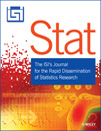
Stat
Exploring the depths of probability and its applications.Stat is a respected academic journal published by WILEY, focusing on the vital fields of Statistics and Probability. Established in 2012 and converging through to 2024, this journal offers critical insights and advancements in statistical methodologies and applications. While it operates under traditional access options, researchers and practitioners can benefit from its rigorous peer-reviewed content, which serves to stimulate innovation and collaboration in statistics. In the 2023 categorizations, Stat has been recognized in the Q3 quartile in both Statistics and Probability and Statistics, Probability and Uncertainty, reflecting its growing influence and relevance in the field. Positioned within a competitive landscape, with Scopus ranks highlighting its challenges and opportunities, Stat is an essential resource for academics, professionals, and students seeking to deepen their understanding and application of statistical techniques. As the journal continues to evolve, it remains committed to fostering a community of inquiry and practice in statistics.
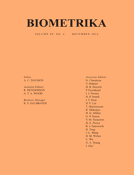
BIOMETRIKA
Advancing the Frontiers of Statistical ScienceBIOMETRIKA, published by the esteemed Oxford University Press, stands as a pivotal journal in the fields of statistics, probability, and applied mathematics since its inception in 1908. With ISSN number 0006-3444 and E-ISSN 1464-3510, this journal maintains an impressive reputation, consistently achieving Q1 rankings across multiple categories including Agricultural and Biological Sciences, Applied Mathematics, and Statistics. Addressed to a global audience from its base in Oxford, United Kingdom, BIOMETRIKA serves as an essential platform for disseminating rigorous research aimed at advancing statistical methodologies and their applications. While the journal does not offer Open Access options, it is recognized for its high-impact output, holding significant positions in Scopus rankings - specifically attaining a 94th percentile rank in General Mathematics and a 91st percentile in Statistics and Probability. Scholars, professionals, and students alike will find in BIOMETRIKA a wealth of knowledge that bridges theory and practice within the vast domain of statistical science, making it indispensable for ongoing research and education in the field.

Stats
Fostering collaboration in the evolving landscape of statistics.Stats, published by MDPI, serves as an invaluable open access platform dedicated to the fields of statistics and probability. Since its inception in 2018, the journal has been committed to disseminating high-quality research and promoting innovation in statistical methodologies through a rigorous peer-review process. Operating from Basel, Switzerland, Stats offers a global reach and aims to foster collaboration among researchers, professionals, and graduate students alike. With an impact factor indicating its emerging significance, the journal resides in the Q4 quartile of the statistics and probability category for 2023 according to Scopus rankings. This positions it within the evolving landscape of statistical research, enhancing its visibility and accessibility. Researchers are encouraged to contribute to this dynamic field and benefit from the journal's dedication to open access publishing, ensuring that research findings can reach a broad audience without barriers.

Statistics and Its Interface
Empowering Researchers Through Cutting-Edge Statistical ResearchStatistics and Its Interface, issn 1938-7989, published by INT PRESS BOSTON, INC, is a vital academic journal dedicated to bridging the critical intersection of statistics, applied mathematics, and interdisciplinary research. With its inaugural publication in 2011, this journal has continually aimed to provide a platform for innovative statistical methods and their application across various fields, offering valuable insights for researchers and practitioners alike. While the journal currently operates without an open access model, it maintains an essential position within the scholarly community, evidenced by its 2023 rankings in the third quartile for Applied Mathematics and the fourth quartile for Statistics and Probability. Furthermore, it holds a respectable position in Scopus rankings, reflecting its commitment to quality over quantity. By publishing cutting-edge research, Statistics and Its Interface serves as a critical resource for advancing statistical knowledge and cultivating a deeper understanding of its applications in real-world contexts.

Thailand Statistician
Advancing Statistical Science in Thailand and BeyondThailand Statistician, published by the THAI STATISTICAL ASSOCIATION, is a pivotal journal in the realms of computational mathematics and statistics. With an ISSN of 1685-9057 and an E-ISSN of 2351-0676, this journal aims to disseminate high-quality research and innovative methodologies that advance the fields of statistics and probability. Covering a range of topics from theoretical statistics to applied computational techniques, it provides a platform for researchers, professionals, and students in Thailand and beyond to contribute their findings and insights. The journal has been gaining recognition, boasting a Scopus ranking of Q3 in Computational Mathematics and Q4 in Statistics and Probability as of 2023. With its commitment to open access, the Thailand Statistician stands as an essential resource for those striving to stay abreast of advancements in statistical methodologies and their applications, fostering the growth of statistical science in the region and globally.
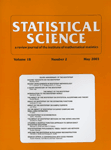
STATISTICAL SCIENCE
Connecting Scholars with Cutting-Edge Statistical Discoveries.STATISTICAL SCIENCE, published by the Institute of Mathematical Statistics (IMS), stands as a premier journal in the fields of Statistics and Probability, commencing its journey in 1986 and continuing through 2024. With an impressive track record reflected in its Q1 quartile rankings in Mathematics, Statistics and Probability, and Statistics, Probability and Uncertainty for 2023, it holds a distinguished position in the academic community. The journal is recognized for its rigorous peer-review process and for publishing high-quality research that significantly contributes to advancing statistical methodology and its applications across various domains. Researchers and professionals are encouraged to engage with its contents to stay abreast of the latest developments and methodologies in statistical science. Although it does not offer open access, the valuable insights provided within its pages are essential for any scholar dedicated to the pursue of statistical excellence. As you navigate the complexities of data analysis and interpretation, STATISTICAL SCIENCE is your go-to resource for groundbreaking research, innovative techniques, and comprehensive reviews.
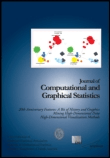
JOURNAL OF COMPUTATIONAL AND GRAPHICAL STATISTICS
Elevating research through innovative statistical methodologies.JOURNAL OF COMPUTATIONAL AND GRAPHICAL STATISTICS is a premier academic publication dedicated to advancing the fields of computational statistics and graphical data representation. Published by Taylor & Francis Inc, this journal stands out with its impressive Q1 rankings in Discrete Mathematics and Combinatorics, Statistics and Probability, and Statistics, Probability and Uncertainty, reflecting its high impact and relevance in contemporary research. Since its inception in 1992, the journal has been a vital resource for researchers, professionals, and students alike, with its rigorous peer-reviewed articles contributing significantly to the science of data analysis and visualization. With a Scopus ranking placing it within the top tiers of its category, the journal is committed to disseminating high-quality research that promotes innovation and methodological advancement. Note that the journal currently follows a traditional subscription model, ensuring focused and curated content for its readers. As it approaches the horizon of 2024, the JOURNAL OF COMPUTATIONAL AND GRAPHICAL STATISTICS continues to foster scholarly discourse and discoveries, making it an essential platform for anyone involved in statistics and data science.
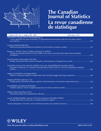
CANADIAN JOURNAL OF STATISTICS-REVUE CANADIENNE DE STATISTIQUE
Your Gateway to Cutting-Edge Statistical ResearchCanadian Journal of Statistics - Revue Canadienne de Statistique is a prestigious publication in the field of statistics, managed by Wiley. Since its inception in 1973, this journal has served as an essential resource for researchers, practitioners, and students, offering insights into a diverse range of statistical methodologies and applications. With its impact reflected in its 2023 categorization as Q2 in Statistics and Probability and Q3 in Statistics, Probability and Uncertainty, the journal stands out among its peers, exemplifying rigorous standards in empirical research. The journal's ISSN is 0319-5724 and its E-ISSN is 1708-945X, providing a robust platform for the dissemination of knowledge in the field. While it does not offer open access, the journal remains highly regarded and well-cited, contributing significantly to the advancement of statistical theory and practice. As it continues to publish cutting-edge research through to 2024, the Canadian Journal of Statistics is a must-read for anyone seeking to stay informed on the latest trends and developments in statistics.
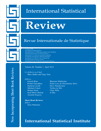
INTERNATIONAL STATISTICAL REVIEW
Fostering Excellence in Statistical CommunicationINTERNATIONAL STATISTICAL REVIEW is a prestigious journal published by Wiley, recognized for its significant contributions to the field of statistics and probability. With an impact factor reflecting its high citation rate and ranking in the top quartile (Q1) of relevant categories, this journal is a vital resource for researchers, professionals, and students alike. Covering a broad range of topics within statistical theory and application, it aims to disseminate innovative research findings and methodological advancements that shape the discipline. The journal's extensive history, converging years from 1982 to 2024, establishes its longstanding commitment to fostering scholarly communication in statistics. While it operates under a subscription model, its rigorous peer-review process ensures that published articles are of the highest quality, providing readers with insightful, reliable, and impactful content. For those looking to stay at the forefront of statistical research, the INTERNATIONAL STATISTICAL REVIEW is an indispensable addition to their academic resources.